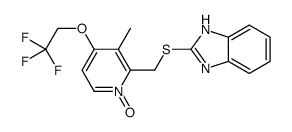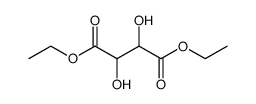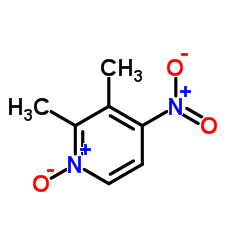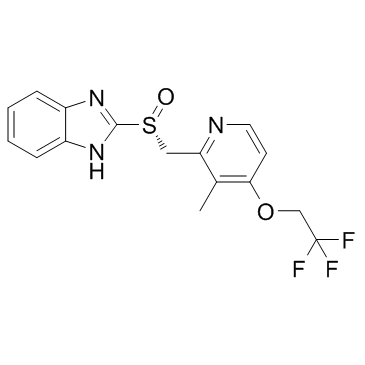103577-45-3
| Name | lansoprazole |
|---|---|
| Synonyms |
2-({[3-Methyl-4-(2,2,2-trifluoroethoxy)-2-pyridinyl]methyl}sulfinyl)-1H-benzimidazole
Ogast Agopton Lanz 1H-Benzimidazole, 2-[[[3-methyl-4-(2,2,2-trifluoroethoxy)-2-pyridinyl]methyl]sulfinyl]- Promp Limpidex 2-({[3-methyl-4-(2,2,2-trifluoroethoxy)pyridin-2-yl]methyl}sulfinyl)-1H-benzimidazole Ulpax Takepron 2-[({3-methyl-4-[(2,2,2-trifluoroethyl)oxy]pyridin-2-yl}methyl)sulfinyl]-1H-benzimidazole MFCD00866873 Zoton 2-[[[3-Methyl-4-(2,2,2-trifluoroethoxy)-2-pyridyl]methyl]sulfinyl]benzimidazole 2-({[3-Methyl-4-(2,2,2-trifluorethoxy)pyridin-2-yl]methyl}sulfinyl)-1H-benzimidazol Lansox Prevacid Ketian Lansoprazole Lanzor Lancid |
| Description | Lansoprazole(AG 1749) is a proton pump inhibitor which prevents the stomach from producing acid.Target: Proton PumpLansoprazole, a substituted benzimidizole proton pump inhibitor, on pharmacokinetics and metabolism of theophylline has been studied in healthy adults given oral lansoprazole 30 mg once daily for 11 days. On Days 4 and 11 of 300 mg aminophylline was simultaneously administered orally and blood samples for theophylline analysis were taken over 24 h [1]. Patients in the lansoprazole group were significantly less likely to have a recurrence of ulcer complications than patients in the placebo group (P=0.008). There was no significant difference in mortality between the two groups [2]. lansoprazole (AG-1749) and omeprazole, were found to have significant activities against this organism. The activity of lansoprazole was comparable to that of bismuth citrate, with MICs ranging from 3.13 to 12.5 micrograms/ml, and fourfold more potent than that of omeprazole [3]. Clinical indications: Duodenal ulcer; Esophagitis; Gastroesophageal reflux; Gastrointestinal disease; Helicobacter pylori infection; Peptic ulcer; Stomach ulcer; Ulcer; Zollinger-Ellison syndromeFDA Approved Date: May 10, 1995Toxicity: Symptoms of overdose include abdominal pain, nausea and diarrhea. |
|---|---|
| Related Catalog | |
| References |
| Density | 1.5±0.1 g/cm3 |
|---|---|
| Boiling Point | 555.8±60.0 °C at 760 mmHg |
| Melting Point | 178-182°C dec. |
| Molecular Formula | C16H14F3N3O2S |
| Molecular Weight | 369.362 |
| Flash Point | 289.9±32.9 °C |
| Exact Mass | 369.075867 |
| PSA | 87.08000 |
| LogP | 2.76 |
| Vapour Pressure | 0.0±1.5 mmHg at 25°C |
| Index of Refraction | 1.635 |
| Storage condition | 2-8°C |
CHEMICAL IDENTIFICATION
HEALTH HAZARD DATAACUTE TOXICITY DATA
|
| Symbol |

GHS07 |
|---|---|
| Signal Word | Warning |
| Hazard Statements | H315-H319-H335 |
| Precautionary Statements | P305 + P351 + P338 |
| Personal Protective Equipment | dust mask type N95 (US);Eyeshields;Gloves |
| Hazard Codes | Xi:Irritant |
| Risk Phrases | R36/37/38 |
| Safety Phrases | S26-S36 |
| RIDADR | NONH for all modes of transport |
| WGK Germany | 2 |
| RTECS | DD9487500 |
| HS Code | 2933990090 |
| Precursor 8 | |
|---|---|
| DownStream 2 | |
| HS Code | 2933990090 |
|---|---|
| Summary | 2933990090. heterocyclic compounds with nitrogen hetero-atom(s) only. VAT:17.0%. Tax rebate rate:13.0%. . MFN tariff:6.5%. General tariff:20.0% |



![2-[[[3-Methyl-4-(2,2,2-trifluoro-ethoxy)-2-pyridinyl]thio]-1H-benzimidazole structure](https://image.chemsrc.com/caspic/087/666727-70-4.png)








